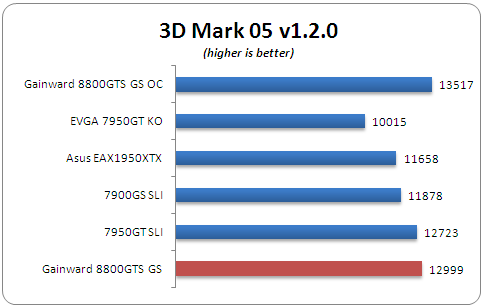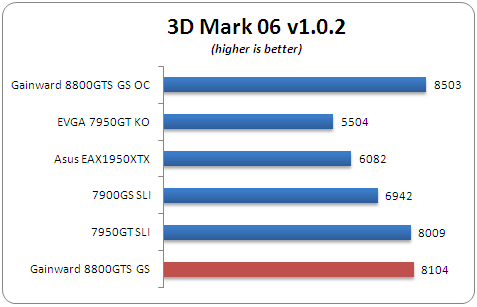Gainward 8800GTS GS
14. Overclocking
There is always a way to improve the performance of your system through overclocking. The Gainward 8800GTS GS is already overclocked, compared with Nvidia's 8800GTS reference board, by 50MHz for Core and 80MHz for memory. We were curious to see if the card could handle even more overclocking. Using coolbits registry "hack", we enabled overclocking in Nvidia's control panel. We tried Ntune to find the optimal performance, but the system was halted every time we tried.

Our next try was with RivaTuner v2.00 Final, which was a success. Overclocking was selectable! Next step was the trial and error process - raise the frequency, run 3D Mark06 to stress test the VGA card and hope for a stable system. Our best efforts are shown below, with the stock clocks included for comparison:
VGA Card |
Core |
Memory |
||||
Stock |
OC |
% difference |
Stock |
OC |
% difference |
|
Gainward 8800GTS GS |
550 |
644 |
17.09 |
880 |
1000 |
13.64 |
The Gainward 8800GTS GS proved to be highly overclockable.

We got a 17.09% improvement for the GPU core and 13.64% improvement for memory. Theoretically, the performance could be higher if a different cooling system is used. After setting the highest possible clocks, we ran a few tests to see if performance improved or not.


3D Mark05 and 3D Mark 06 benefited from the increase in GPU and Memory clocks. We tried several games and we also saw an increase in framerate. For example, Prey reached 105FPS (vs 90) with 4xAA/16xAF mode enabled. Lastly, we monitored the GPU temperature as reported by RivaTuner, when running a 3D Mark 05 score. Even when overclocking, the temperature didn't exceed 74°C, while at idle it was at 61°C. Without overclocking, the Gainward 8800GTS GS reaches 59°C.






















